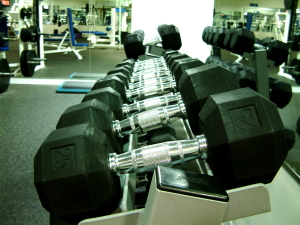Strength training is any training that is done which will improve an athlete’s strength. This type of training affects performance by causing muscular hypertrophy, which is a grow th in myocyte cross-sectional area. Strength training causes a large stress on the muscle being used, causing minor tears in the muscle. The body responds to these high intensities by increasing he size of the muscles to increase muscular strength so that the next time the intensity is encountered it can be lifted without causing as much damage. Strength training often involves: sets (how many times an exercise is repeated), repetitions (how many times the set resistance is lifted), a set resistance (can be a set weight such as 20Kg or a set intensity such as 10 RM) and a rest period between sets. Strength training can be done using isometric or isotonic contractions. Isotonic is more frequent. This training type is suited to many sports, but particularly for sports where muscular strength is one of the key components of fitness. These sports include: martial arts, rugby, Greco-Roman wrestling, American football, and strongest man competitions. There are various methods within this type of training, which include: weights, elastics and hydraulics.
th in myocyte cross-sectional area. Strength training causes a large stress on the muscle being used, causing minor tears in the muscle. The body responds to these high intensities by increasing he size of the muscles to increase muscular strength so that the next time the intensity is encountered it can be lifted without causing as much damage. Strength training often involves: sets (how many times an exercise is repeated), repetitions (how many times the set resistance is lifted), a set resistance (can be a set weight such as 20Kg or a set intensity such as 10 RM) and a rest period between sets. Strength training can be done using isometric or isotonic contractions. Isotonic is more frequent. This training type is suited to many sports, but particularly for sports where muscular strength is one of the key components of fitness. These sports include: martial arts, rugby, Greco-Roman wrestling, American football, and strongest man competitions. There are various methods within this type of training, which include: weights, elastics and hydraulics.
Weight training involves lifting a certain weight against gravity to train specific muscles or groups of muscles. This method of training can use both fixed weights and free weights. Free weights often involve lifting dumbbells, barbells and sometimes the weight plate it self. This method of training causes the body to not just develop the major muscles being used in the activity, bt also develops the smaller muscles used to stabilise the movements. Fixed weights utilise machines to lift the weight and often have a pulley system. The advantage of this method is that it helps the athlete to learn the correct technique and to experience equal resistance throughout the full range of motion. Weight training is the dominant form of resistance training when large gains in strength are required or when a large resistance is desired. It is most suited to sports that require large amounts of strength or power. These sports include: rugby, shot-put, Greco-Roman wrestling, and American football.
self. This method of training causes the body to not just develop the major muscles being used in the activity, bt also develops the smaller muscles used to stabilise the movements. Fixed weights utilise machines to lift the weight and often have a pulley system. The advantage of this method is that it helps the athlete to learn the correct technique and to experience equal resistance throughout the full range of motion. Weight training is the dominant form of resistance training when large gains in strength are required or when a large resistance is desired. It is most suited to sports that require large amounts of strength or power. These sports include: rugby, shot-put, Greco-Roman wrestling, and American football.
Elastic training uses various forms of elastic to provide the resistance to develop strength. The intensity of this type of training is limited and the resistance increases as the elastic is stretched. The benefit of this method is that it is highly portable making it useful in home gyms or for personal trainers. This method of strength training is often used in rehabilitation, especially of weaker muscles. This method of training is best suited for sports, which require use of the smaller muscles. These sports include: arm wrestling, darts and Javelin.

Hydraulic training uses machines, which use water or air compression to provide the resistance throughout the movement. This method of training increases the resistance the faster the movement is executed. So with slow movements the resistance is small, whereas with a quick movement the resistance is large. This method of training is good for sports that require fast movements through a resistance. These sports include: rugby league, swimming, boxing and other martial arts

